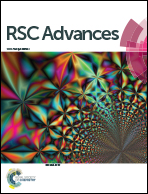Preliminary characterization and immunomodulatory activity of polysaccharide fractions from litchi pulp†
Abstract
Two purified fractions were prepared by the sequential purification of litchi pulp polysaccharide (LP) through ion-exchange chromatography and gel-filtration chromatography. Their preliminary structures and immunomodulatory activities were investigated. The two fractions, LPI and LPII, were homogeneous heteropolysaccharides mainly composed of arabinose, glucose, galactose and mannose with average molecular weights (Mws) of 213 and 36.9 kDa, respectively. LPII was quite different from LPI; it had a triple helix structure and a much higher content of neutral sugar, uronic acid, arabinose, glucose and mannose (p < 0.05). Nuclear magnetic resonance (NMR) spectroscopy data showed LPI contained α-D-Galp and α-L-Araf-(1→ and LPII was consisted of →3)-α-L-Araf-(1→, β-(1 → 2)-Galp and →4)-α-D-Glcp-(1→. The results from in vitro immunomodulatory activities indicate that LPII was a better stimulator than LPI on splenocyte proliferation, cytokine secretion and natural killer (NK) cell cytotoxicity from 100–300 μg mL−1 (p < 0.05). LPII exhibited stronger immunostimulatory activity, which may be attributed to its unique structure.


 Please wait while we load your content...
Please wait while we load your content...